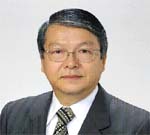Director: Hiroshi Nakatsuji

Research Theme
- General Methods of Solving the Schrödinger and Dirac Equations were proposed (2000-2007). In his theory, the Hamiltonian of the system paves the way to its exact ground and excited wave functions, producing the complement functions that span the potentially exact wave functions. Variational calculations give super accurate results and local Schrödinger equation (LSE) method provides a general integral-free method that is applicable to any atoms and molecules. See, Acc. Chem. Res. 45(9), 1480-1490 (2012) for a review.
- SAC-CI Theory for Molecular Excited and Ionized States (1978) is useful to study singlet-to-septet ground and excited states of organic and inorganic molecular systems and the energy gradient of each state. It has been applied to fine spectroscopy, photobiology, surface photochemistry, and giant molecular systems. This program is implemented in Gaussian.
- Dipped Adcluster Model (DAM) for Surface-Molecule Interactions and Reactions (1987) is a theoretical model for chemisorptions and catalytic reactions on a metal surface. It includes the effects of bulk metal like electron transfer and image force. DAM has been useful to clarify surface chemistry like electron harpooning and transfer, olefin epoxidation reactions on Ag surface, etc.
- Theory for the Direct Determination of Density Matrix: Density equation that is equivalent to the Schrödinger equation in the density-matrix space was presented (1976) and solved for real molecules (1996). Variational principle for 2-density matrices was formulated using the positive definite algorithm (2001).
- Intuitive Force Concept for Molecular Geometry and Chemical Reaction was developed (1973) based on the electrostatic (Hellmann-Feynman) theorem. It is more useful than the VSEPR theory and the Walsh model. Electron-cloud preceding (1974) was shown to be a common behavior in the course of the chemical reaction.
- Electronic Mechanism and Relativistic Effect in NMR Chemical Shifts: Electronic mechanism of the metal chemical shift is an intrinsic property of the resonant nucleus, characterized by its position in the periodic table (1984-1993). Relativistic effects are of crucial importance for molecules including heavy elements (1995-2003) even when the resonant nucleus is light.
Hiroyuki Nakashima
| Recently, the method converging to the exact solution of the Schrödinger and Dirac equations was proposed. Based on the extremely accurate solutions, our purpose is to realize predictive quantum chemistry for atomic and molecular science. Research interests: (1) Very accurately solving the Schrödinger equations of atoms and molecules (2) Solving the non-BO Schrödinger equations and analytical potential energy curves applied to chemistry (3) Relativistic quantum chemistry with the theory of the exact wave function (4) Space and ultimate science with the accurate quantum chemistry (5) Quantum mechanical principle behind life phenomena private page |
 |
Yusaku I. Kurokawa
| Research Theme: General method to solve the Schrödinger and Dirac equations. (1) I have solved the Schrödinger equations for hydrogen molecule and helium atom very accurately using the Free Complement (FC) method. Now, I am trying to apply the FC method to other systems. (2) When two charged particles come close with each other, the wave funciton satisfies some conditions which is known as cusp condition. Now, I am trying to extend and generalize cusp conditions. private page |
  |
Research office
Mieko Nakatsuji
Hiroyuki Nakashima
Fellow
Hiromi Nakai (Waseda Univ.)
Masahiro Ehara (Institute for Molecular Science)
Jun-ya Hasegawa (Catalysis Research Center, Hokkaido Univ.)
Takamasa Momose (The University of British Columbia, Canada)
Hiroshi Sugiyama (Graduate School of Science, Kyoto University)
Yasushi Honda
Ryoichi Fukuda
Tomoo Miyahara
Atsushi Ishikawa (Institute of Science Tokyo)
Henryk Witek (NYCU Academic Hub)
Annika Bande (Helmholtz-Zentrum Berlin)
Tadamasa Shida
Yuko Ito
Collaborators
Roberto Cammi (University of Parma, Italy)
Takehiko Wada (Institute of Multidisciplinary Research for Advanced Materials, Tohoku Univ.)
Yung-Ching Chou
Johanna Langber
Fang Tao
Cong Wang
Sergiy Bubin (Nazarbayev Univ.)
James S. M. Anderson



